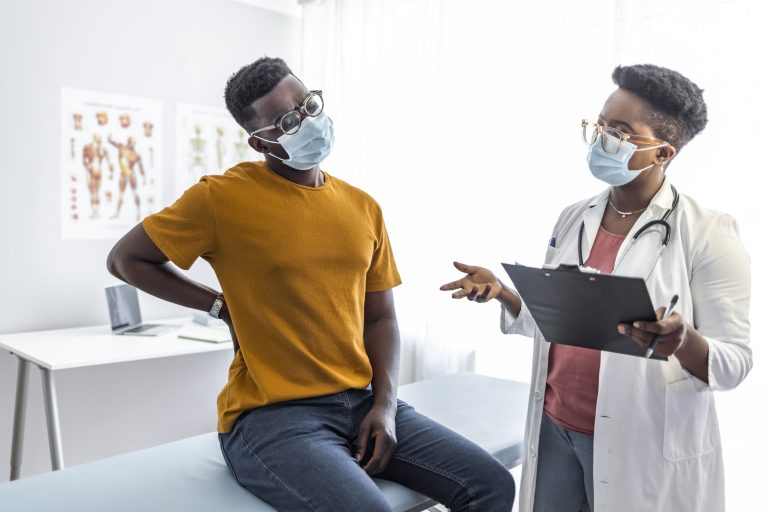Persistent back pain can be debilitating and it can keep you from the people and activities you love. Back pain can stem from some conditions ranging from bone spurs to arthritis to other degenerative spine conditions. As a patient, it’s important to be as educated as possible on the condition you have.
At BEST, we understand that living with severe back pain can be frustrating and difficult. Read through this guide to learn how you can combat back pain and get back to the quality of life you deserve.
What Can Cause Back Pain
Back pain can be caused by several different conditions, some more severe than others. There are also different types of back pain. Back pain can range from your lumbar (lower), thoracic (middle), or cervical (upper) spine. The following are a few conditions that can affect the spine.
– Arthritis of the Spine. This condition can cause pain, tenderness, stiffness, and swelling in the body’s joints. Osteoarthritis is a common spinal condition that is caused by degenerating joints.
– Bulging Disc. A bulging disc is also known as a disc protrusion. They are very common and occur in people of all ages.
– Failed Back Surgery Syndrome. Also known as FBSS, this condition occurs when a patient who undergoes spinal surgery experiences previous or new symptoms after a surgical procedure.
Three Treatment Options for Back Pain
Treatment varies between patients. Most treatment plans are unique to the patient as each takes into consideration the type of spinal condition, the severity, and the lifestyle the patient leads. Consider these treatment options to help reduce your painful symptoms.
1. Physical Therapy Programs
BEST offers physical therapy as a conservative treatment option. Consider these two programs that can help reduce symptoms.
- Soft Tissue Mobilization. Physical therapists typically have patients undergo hands-on examinations to determine what exercises and techniques will reduce pain and increase function. A healthcare professional may recommend therapeutic friction massages or assistive instruments based on the patient’s progress.
- Dry Needling. To relieve pain and other symptoms, physical therapists and other health care professionals use dry needling, also known as trigger point dry needling. During the procedure, thin needles are inserted carefully into muscle trigger points, which are tight, contracted bands of tissue that can cause pain and reduce mobility. Dry needling can relax tense muscles, relieve pain, and increase blood flow by breaking up painful bundles of muscle tissue.
2. Blood Flow Restriction Training
Using blood flow restriction training, you can improve muscle strength without lifting heavy weights. During training, a patient wears a pressurized band or cuff to restrict blood flow to specific muscles. It can improve mobility and posture by helping patients deal with muscle weakness and regain strength.
The patient normally sits or lies on a table during a blood flow restriction training session. To restrict blood flow, the physical therapist positions the band or cuff on the upper or lower extremity. Due to the restriction, a physical therapist will guide the patient through a series of strengthening exercises that will require less resistance than normal.
3. Orthotics
The term orthotics refers to an array of devices that modify the musculoskeletal system’s structure and function. Those with injuries, degenerative conditions, and neurological conditions may benefit from orthotics. One of the basic ideas behind orthotics is that the musculoskeletal system is highly interconnected, so one small injury can lead to more serious complications.
Spinal orthoses include neck or back braces, which can help align the spine and improve posture to reduce pain related to conditions such as herniated discs, or during the postsurgical recovery stage. A healthcare professional will recommend orthotic devices based on an evaluation of the patient. The evaluation will include fitting and testing to ensure that the device is suitable for the individual.
How BEST Can Help
At BEST, we take pride in our state-of-the-art facilities as well as our exemplary patient care. We believe that the patient’s experience is just as important as the treatment they receive. BEST has multiple facilities, each specializing in different care. In addition, we can provide imaging with our on-site MRI, X-rays, and CT scans. These imaging diagnostics help our doctors reach a conclusive diagnosis. We also offer conservative treatment options such as physical therapy.
We view surgery as a last resort and it is only offered when conservative treatments have been fully explored but have not provided the relief necessary. Our minimally invasive surgery is a safer and more effective alternative to traditional open spine surgery. The procedures at BEST, are performed by our board-certified surgeons, Dr. Girton and Dr. Abbott. They employ muscle-sparing techniques using an incision typically less than an inch. This reduces the overall recovery period, eliminates the need for an overnight hospital stay, and lowers the risk of complications.
If you would like to learn more about BEST, reach out today!
